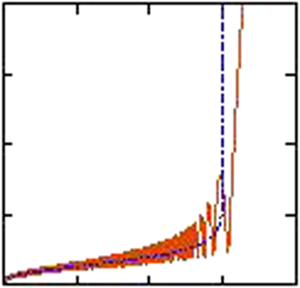Article contents
Viscous and electro-osmotic effects upon motion of an oil droplet through a capillary
Published online by Cambridge University Press: 24 July 2020
Abstract

In the context of waterflooding in oil recovery, the motion of an oil droplet through a capillary pore initially filled with aqueous liquid is considered. The droplet is affected by capillary and viscous forces, with a thin aqueous film being formed between the droplet and capillary wall. Moreover, the droplet surface and capillary wall surface have opposite and equal electrical charge. Attractive electro-osmotic interactions then tend to thin the film. A case is considered in which electro-osmotic interactions are strong and capillary forces are inherently weak, leading, in the first instance, to a viscous, electro-osmotic balance. Solutions are obtained for the droplet shape close to its front end. Whilst visco-electro-osmotic dominated solutions can indeed be found, additional solution classes are identified for which the film thickness oscillates with longitudinal position, and capillary forces regain importance. A parametric study is presented indicating that oscillation length scales along the film can be selected such that capillary effects never become negligible. Moreover gradients of electro-osmotic conjoining pressures are small in thinner parts of the film, even though electro-osmotic conjoining pressures themselves are not. Thus, rather than a visco-electro-osmotic balance being the norm, a capillary, viscous balance results in thinner parts of the film, giving way to a capillary, electro-osmotic balance in thicker parts. However, solutions are non-unique, and a given system can admit multiple solutions with films of various different thicknesses. Some of these solutions have films that increase monotonically in thickness with position, while others fall into the oscillatory class.
Information
- Type
- JFM Papers
- Information
- Copyright
- © The Author(s), 2020. Published by Cambridge University Press
References
REFERENCES
- 6
- Cited by

